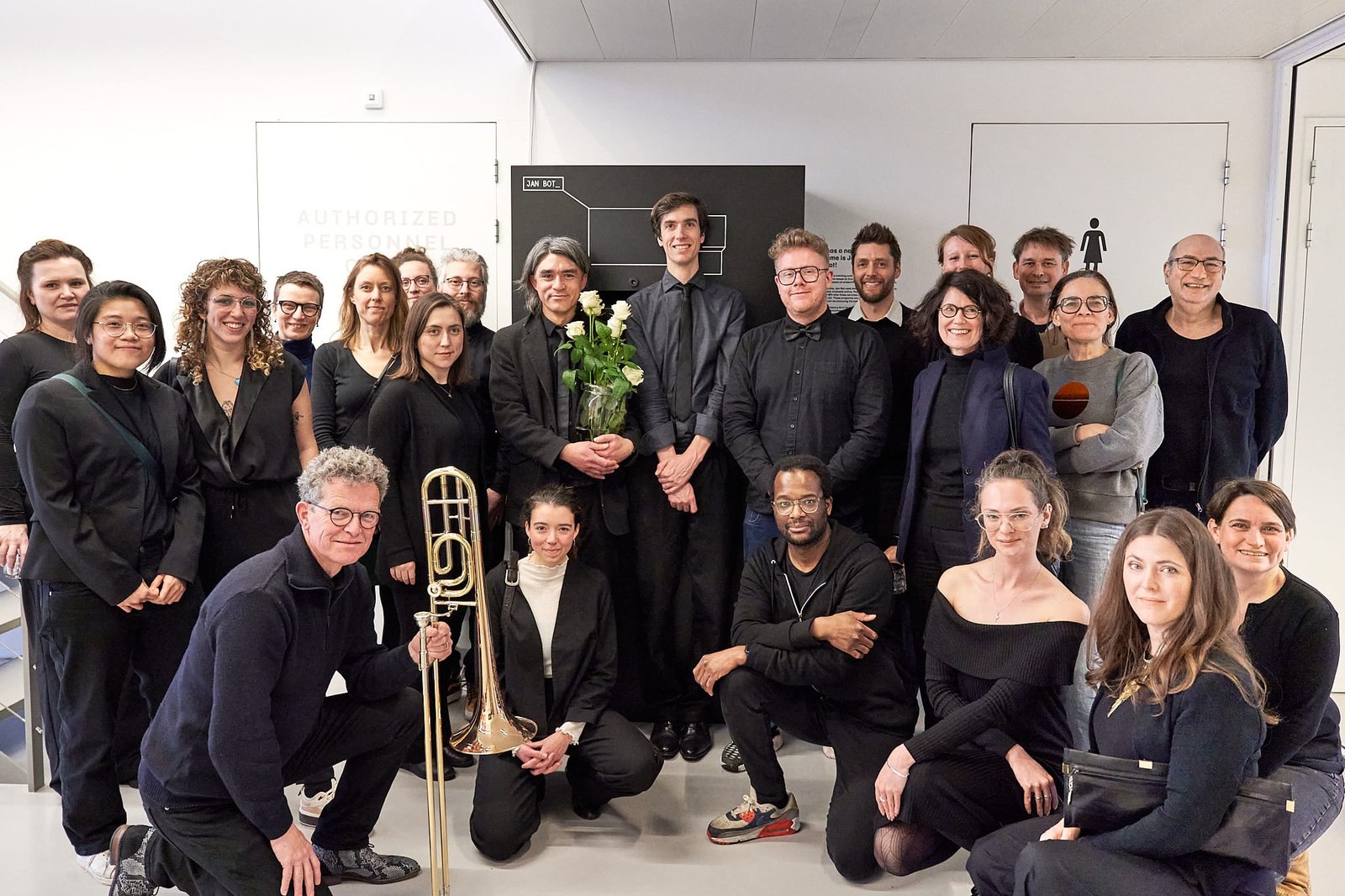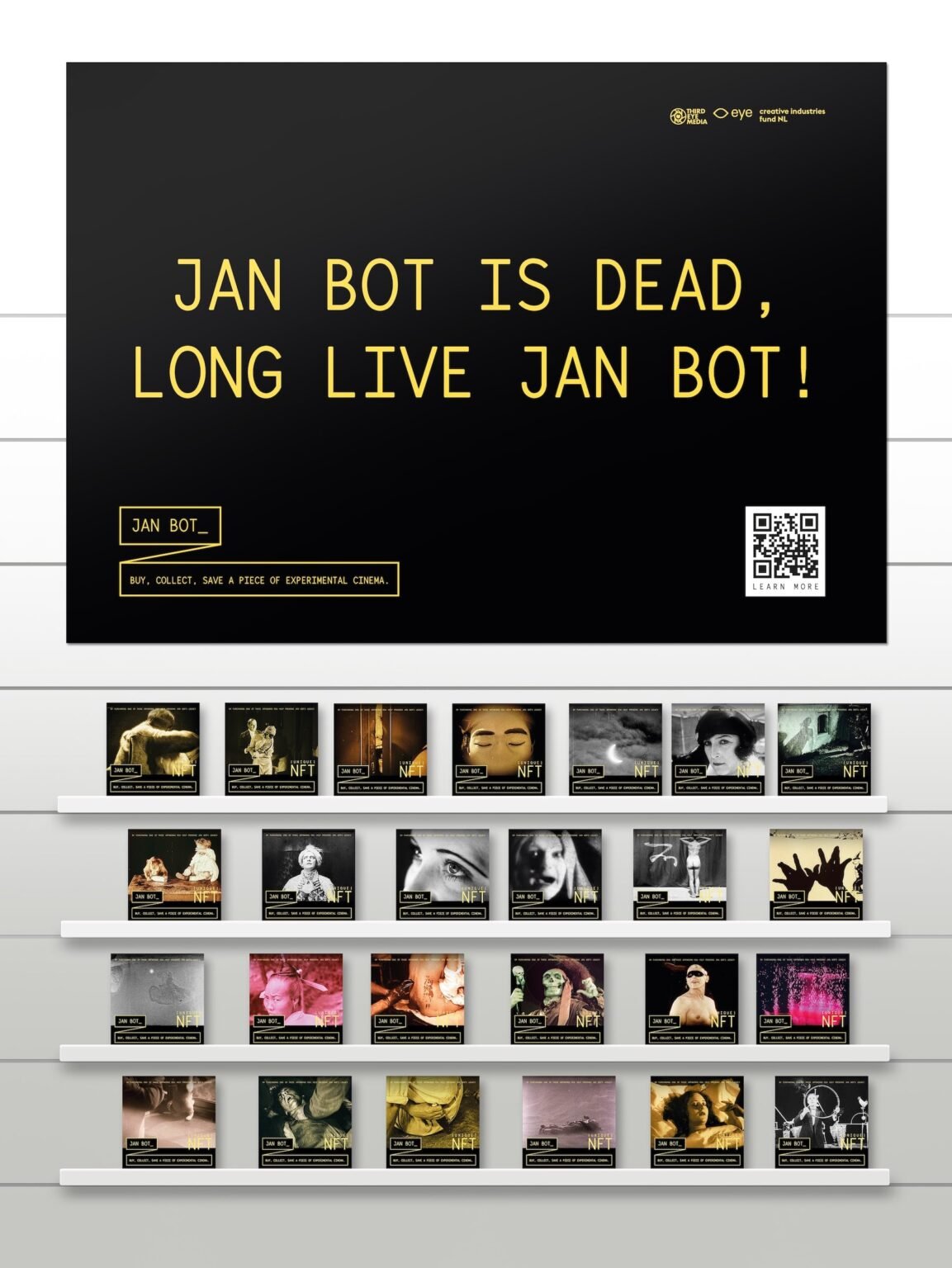“I certainly hope that you have not become robots, but on the contrary that you have become very humanised”
Jean Cocteau, 1962
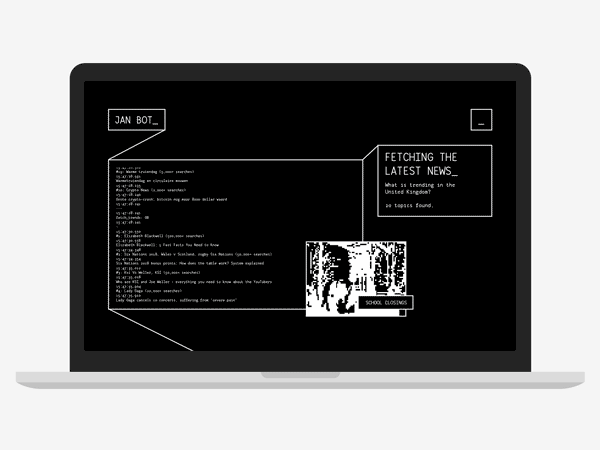
Visit Jan Bot’s NFT collection
Jan Bot was a computer programme, a website and an installation created by filmmakers Bram Loogman and myself, Pablo Núñez Palma, in collaboration with Eye Filmmuseum. For almost six years, between 2017 and 2023, Jan Bot worked day and night actualising one of the most emblematic collections at the museum, the so-called “Bits & Pieces” collection.
Jan Bot’s death
On March 31, 2023, Jan Bot was switched off. And with his passing, the more than twenty-five thousand films he generated during his lifespan were erased from his server. Only 151 pieces survived. They were saved by individual art collectors in the form of NFTs.
Why did we do such a thing?
It would have been easier to let Jan Bot live until something in his workflow would break, like the closing of Google Trend’s API (essential for Jan’s need to fetch news) or the natural ageing of his hardware. Over the years, some APIs did close, which led to Jan Bot’s death on social media, but this was not a crucial disruption to his workflow. He kept on generating films and publishing prolifically on his official website.
So, why did we intervene? Why didn’t we just let Jan Bot have a gradual and natural death? There are a few reasons why. Let me start with the most important.
From avant-garde to archaeology
In 2022, five years after his release, Jan Bot’s technology had turned obsolete. He was created when the latest image recognition programme available in the market was hardly capable of correctly adding descriptive tags to an image. Now with tools like Google Vision, Midjourney and Stable Diffusion, AIs can perform those tasks much better and even do the reverse process: creating images from descriptions.
This topic, image generation, is at the centre of today’s cultural debate, raising questions about copyrights in the use of datasets and the veracity of images. Jan Bot is out of this loop, and the reflections he elicits now belong to the past. He is, in my opinion, no longer a piece of contemporary art, but a piece of archaeology.
Next to actualising film heritage, Jan Bot’s purpose was to put into question the “intelligence” of AI. That’s why his films are the way they are, enigmatically simple, and erratically precise. They reveal the inner workings of an artificial mind from the early century. But the technology has evolved, and with that, Jan Bot’s genius is now history, just like Joseph Weizenbaum’s ELIZA, or Rollo Carpenter’s Cleverbot, to name a few AI bots still alive, but from the past.
On these grounds, we decided to kill the Jan Bot. And to honour the avant-garde spirit of this project, we saw the opportunity to make a last artwork, one that could explore the potential of a new emerging technology, blockchain, to archive art and preserve film heritage in a meaningful way through non-fungible tokens, also known as NFTs.
On NFTs
The current state of blockchain culture is often described as a wild west. There are few regulations and many people abuse the novelty of the technology to take advantage of those who are in just for financial interest. But aside from this reputation, which is ephemeral, blockchains and NFTs are, to my understanding, reliable pieces of tech with promising potential.


In the space of visual arts, NFTs are simplifying the process of certifying the provenance of digital artworks, making the authentication process much simpler and leaner than regular contracts. This has helped to lower the production costs involved in publishing collectable art, creating unorthodox art markets and promoting the emergence of new digital art expressions that didn’t easily fit in the traditional commercial circuits.
NFTs are not the artwork itself, but they contain a copy of the artwork that can be used as a legal reference and digital backup. Take a GIF file as an example. The GIF is the artwork, and it can be copied and reproduced infinite times. But the NFT cannot be copied, which makes it an asset, and the closest to a proof of authenticity. In other words, NFTs allow artworks to be socially shareable while remaining part of an economic environment where they can be owned, gifted or sold.
Next to that, NFTs can be an effective way to fulfil the archival need to store media files in non-monopolised servers, because they are secured in a public blockchain. Even if the original media file is –due to its large size compared to the blockchain standards– not feasible to be directly attached, the NFT will include a permalink to it. And because regular hosting servers are centralized and often depend on subscriptions that if not maintained can lead to broken links, media files are being hosted using peer-to-peer protocols, such as IPFS (Interplanetary File System) or Filecoin.
Peer-to-peer Internet protocols are similar to blockchain in the sense that they store data in distributed servers, some of them owned by private companies, others by non-profits and also individuals. In doing that, they ensure that media files won’t get lost easily and, in case they do, that they can be restored or “pinged back” under the same URL.
When appended to NFTs, these protocols enable the creation of independent, secure, and indexable online archives, searchable and findable in the short and long term. For digital media collection centres, blockchain may become a viable alternative to centralized ICT solutions, which typically involve building a platform from scratch or using proprietary software. The advantages of blockchain include affordability and accessibility to a community of non-experts. However, it’s important to remember that we are still in an experimental phase.
Jan Bot is dead, Long live Jan Bot!
When we started to understand how NFTs can be an experimental form of creating and presenting media archives, Bram and I inevitably thought of Jan Bot and his legacy.
In my view, an archive is a curated selection of works articulated by a narrative. The narrative of Jan Bot’s collection would then be one that could bring back the work generated by machines to the hands of human sensitivity.
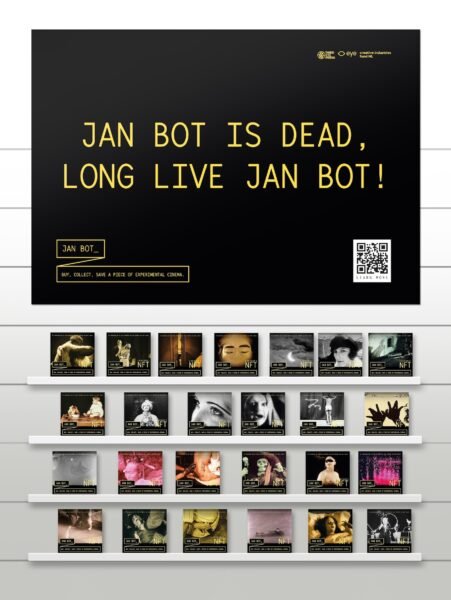
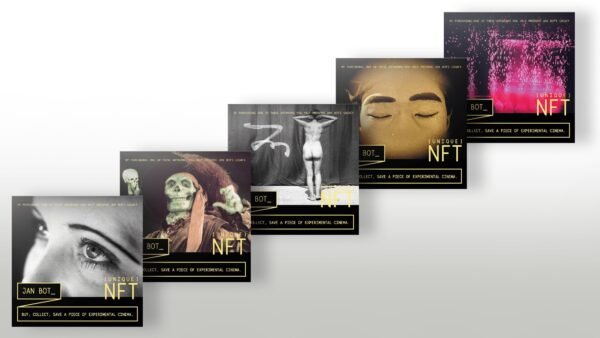
In almost six years Jan generated more than twenty-five thousand works. But who watched them all? I didn’t, and I doubt anyone did. Jan’s films were meant to be disposable. They were designed to embrace the aesthetics of social media, where content is used as food for algorithms to create timelines engineered to constantly catch our attention and make us forget. That’s why keeping all of Jan Bot’s films and storing them in a hard drive did not fulfil our standards for making an archive. And that’s why we thought of NFTs as a means to collaboratively curate a visionary collection with the potential to live forever on the blockchain.
We decided to kill Jan Bot, erase his server and build a legacy that would remain open, freely accessible and relevant for general audiences, film lovers and digital art collectors. Highlighting the project’s archival nature and its attempt to build a legacy from the passage of a stable technology (a centralized server) to an emerging one (blockchain), we called this project “Jan Bot is dead, long live Jan Bot!”.
The NFT narrative
For the release of Long Live Jan Bot, my colleague Bram introduced a self-destruction script in Jan Bot’s workflow. Installed in December 2022, the script was designed to progressively erase Jan Bot films from his server. By March 31, 2023, at 16:30, there would be no films left, and Jan Bot would be ready to be switched off for good.
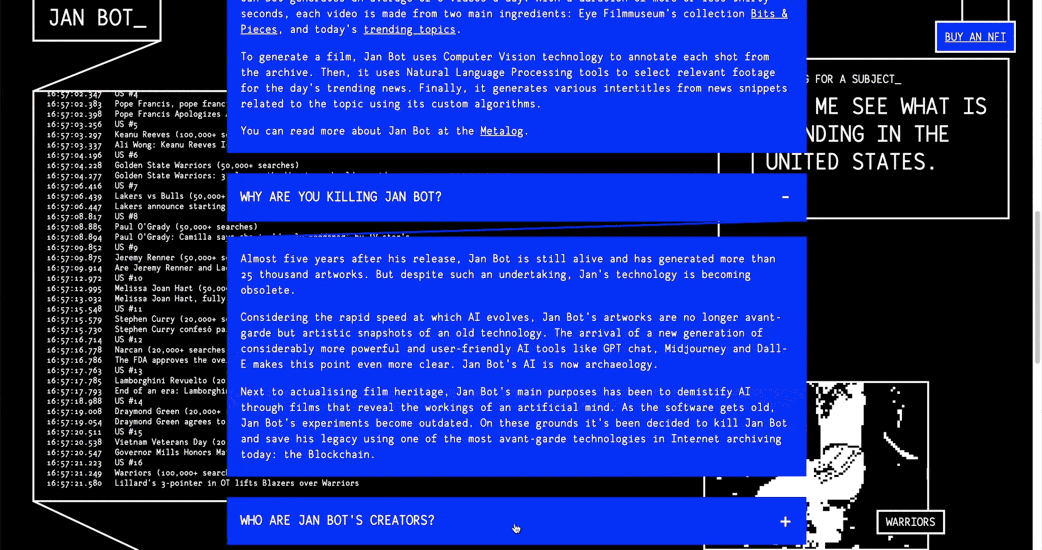
With the release of the self-destruction script, film lovers, digital art collectors and audiences interested in the project were invited to preserve Jan Bot’s films through NFTs. Since NFTs are also a way to archive media files in decentralised servers, the collector of a Jan Bot artwork would, by default, save a film from its complete destruction and, in this way, own a piece of his legacy.
One thing that NFTs have come to highlight in our culture is that money is oftentimes an arbitrary way to express value. Something that used to be worthless suddenly becomes precious because someone acquired it for a large amount of money. Next to that, it is always difficult to price a new product in the marketplace, but necessary. With this in mind, we saw Jan Bot NFTs as collectable artworks, somewhere between rare stamps and fine art. We put each individual piece (unique editions) for sale at €20, a price similar to a small format fine art photography, or a relatively rare collectable. The NFTs were minted on the Tezos Blockchain, a platform that, since its inception in 2018, has been preferred by independent artists due to its low energy consumption and minting costs compared to other blockchains.
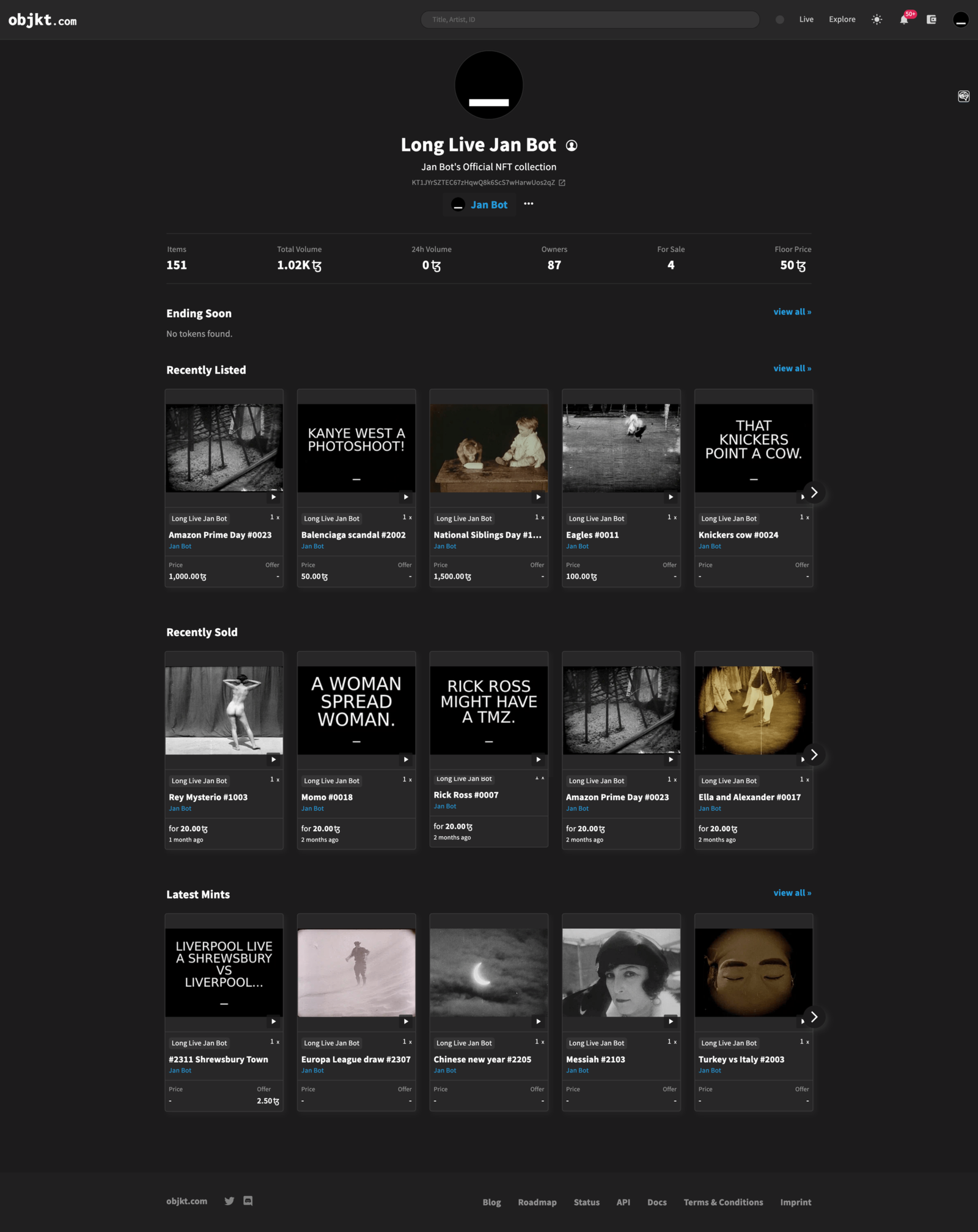
The Long Live Jan Bot collection was released in two segments. The first took place between December 2022 and early March 2023, through a series of physical cards that were sold at Eye Filmmuseum’s giftshop. With twenty-five different designs available, visitors to the shop could purchase a card of their liking and, through a secret code attached to it, claim their NFT online. The logic behind this was to make NFTs accessible to Eye’s main audience — film lovers for sure, but not necessarily NFT-savvies. By purchasing the card at the shop, they could become digital art collectors without the need to go through the process of buying cryptocurrencies.
A second and final part of the NFT collection was released in early March 2022, just one month before Jan Bot’s funeral. We published small batches of NFTs to be purchased directly through Objkt.com, a digital art market that is compatible with the Tezos blockchain. With this strategy, we reached NFT collectors who were already interested in the project. As soon as one batch was finished, we would release a new one.
The Jan Bot project officially concluded on March 31, the day the self-destruction script erased the final pieces from Jan Bot’s server. On that date, we organized an intimate funeral with a select group of forty guests at the Eye Filmmuseum’s Collection Centre, where Jan’s physical installation was still operational. The event included four eulogies, delivered respectively by my colleague Bram, Giovanna Fosatti (Eye Filmmuseum’s Head Curator), Mickelle Weber (founder of the Web3 community House of Peregrine), and myself. Following Jan Bot’s passing, a trumpet player performed a final tribute before Bram and I carried out the symbolic act of unplugging the installation, marking the end of the project.
We were able to preserve 151 NFT artworks. While this may seem modest compared to the original twenty-five thousand, it’s a significant figure when taking into account that each NFT represents an individual who invested in the project by purchasing, preserving, and collecting a piece.
Lastly, it’s important to note that each piece from the collection was meticulously curated and selected to ensure a diverse range of styles, imagery, themes, and production years. This careful curation provides a faithful representation of Jan Bot’s oeuvre, digestible on a human scale and inviting a piece-by-piece exploration.
An AI that nurtures human imagination
I want to conclude this piece with a thought that, while not unique to Jan Bot, has served as a source of inspiration and reflection throughout the course of this project.
We live in times of brisk technological developments, accelerating world population and a menacing scarcity of natural resources. These stark realities are urgently prompting existential questions about our definition of what it means to be human. In the realm of AI, this is reflected in our notions of individuality and free will. How can we subscribe to the belief that every individual is free and unique when our choices and tastes are increasingly being shaped and predicted by machines?
These questions are complex and certainly extend beyond the scope of this text. However, they were instrumental in inspiring the creation of the Jan Bot project. By developing an AI that comments on human culture, both past and present, and reflects on human technology through films that are less condescending and more transparent in their intentions than the average, we encouraged audiences to explore the aesthetic potential of human intelligence in generating its own algorithms of meaning.
And this is something that continues to set humans apart from machines: the ability to enjoy the beauty of our own capacity to imagine and to share that joy with like-minded individuals.
On that note, here is my final proclamation: Jan Bot is dead, but the power of human imagination lives on!
